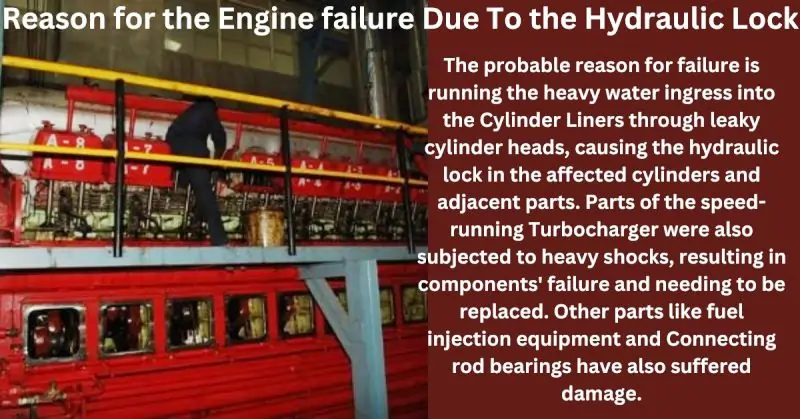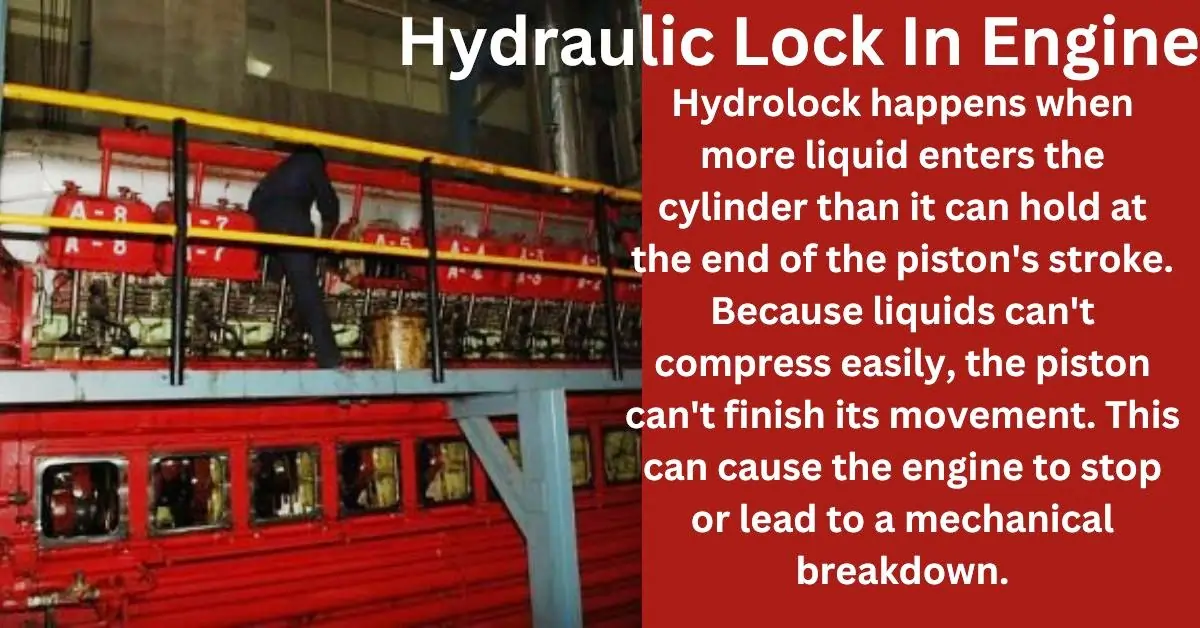Hydraulic Lock In Engine
Engine Failure Due to Hydraulic Lock: A Real-Life Catastrophe
In this blog post, we’ll talk about a real-life engine failure caused by a hydraulic lock. I saw this happen when advising an authorized agent of a well-known diesel engine company.
The term “hydraulic lock” might sound complicated, but we’ll simplify it. We’ll look at what caused this incident and how bad it was.
Engine problems can be small or big, but a hydraulic lock is one of the worst things that can happen to an engine. It’s a serious and destructive failure. So join us on this adventure as we relate the tale of an engine that suffered severe damage from a hydraulic lock. We’ll describe what occurred and what lessons might be drawn from it.
Hydraulic Lock Engine Failures: A Historical Overview
This incident occurred in 2020 at an automobile factory with a 3.8 MWe capacity engine. The engine was in Emergency Diesel Generator (EDG) mode when a government electricity supply interruption prompted the diesel generator operator to start the engine.
During the engine’s startup, the shift engineer heard an unusual noise, and the engine’s speed began to decrease, causing a drop in frequency. The shift engineer stopped the engine with the emergency stop button to prevent further damage to the machine.
Subsequently, the engineer engaged the engine’s turning gear but encountered resistance, making it difficult to turn the engine. Recognizing the seriousness of the situation, the engineer promptly notified the power plant manager.
The engineer carefully looked into the problem to figure out why it happened. This involved opening all the crankcase doors. During the inspection, the engineer found that one connecting rod was jammed and had a clear bend in the middle.
My Role in Investigating Hydraulic Lock Engine Failure
The power plant manager contacted me urgently, and I rushed to the site, which was located on the National Highway in Gurgaon, just after a one-hour journey from Delhi. Upon my arrival at the factory, I immediately began investigating the root cause of this catastrophic engine failure.
To get to the bottom of the issue, I instructed the engineers to dismantle the affected unit. As we carefully disassembled the engine, we discovered several significant damages:
- Valve Driving Gears and Cylinder Liners: The valve driving gears suffered damage, as did the cylinder liners, which displayed deep vertical scoring marks along their entire working surfaces.
- Cylinder Heads: Damage was also evident on the cylinder heads.
- Piston Rings: All the piston rings in the entire unit were damaged.
- Push Rod and Valve Guide Housing: These components showed signs of damage.
- Fuel Injection Pump (FIP) Parts: The barrels, plungers, and other parts of all the Fuel Injection Pumps were damaged.
- Turbocharger (TC) Components: Damage extended to the TC compressor wheel, nozzle rings, and associated parts.
- Connecting Rods: Further examination revealed damage to the connecting rods as well.
The extent of the damage was alarming, and it was clear that a thorough investigation was required to determine the precise causes of these failures. This incident was a stark reminder of the critical importance of regular maintenance and vigilant industrial equipment monitoring to prevent such catastrophic breakdowns.
Reason for the failure

The probable reason for failure is running the heavy water ingress into the Cylinder Liners through leaky cylinder heads, causing the hydraulic lock in the affected cylinders and adjacent parts. Parts of the speed-running Turbocharger were also subjected to heavy shocks, resulting in components’ failure and needing to be replaced. Other parts like fuel injection equipment and Connecting rod bearings have also suffered damage.
My further analysis to ascertain the root cause of water ingress into the cylinders and engine crankcase, which was the cause of the catastrophic failure, is as mentioned below.
- Staff carried out the hydraulic test of the affected cylinder heads. There was water leakage from the valve seat area near the channel.
- On further investigation and close observation, the symptoms of a combination of cold corrosion from sulphuric acid and normal erosion from the particles in the exhaust gas.
- The origination of corrosion was due to the sulphuric acid from the sulfur contents. The corrosion starts when the surface temperature of the cylinder head is below the dew point of sulfur.
A complete list of damaged parts, with the parts that need replacement to make the Engine Operational, is attached herewith.
A picture of the damaged parts is reproduced below.
Recommendations to avoid future failures
During the normal starting, the Engine follows the following starting procedure.
Turn the Engine by keeping the indicator cocks in an open position
Blow through the Engine with air and keep a close watch on the indicator cocks.
Please take the necessary action if water happens during the air turning off the engine.
Never attempt to start the Engine if any fuel or water particles are seen from the indicator cocks.
It is mandatory to follow all the points mentioned above. Engine starting procedures must be followed for the trouble-free operation of the DG set. These points are crucial for the DG sets used in EDG operations.
An engineer with experience should be allowed to start the Engine. It is always advisable to keep cool during an emergency. Creating panic will worsen the situation. In light of my experience, I have seen that engineers commit mistakes after getting panicky.
Author’s Experience on Failures
In the recent past, the available fuel for the Diesel power plant is of inferior quality. Fuel contains a heavy amount of sulfur content.
Heavy sulfur contents are the main cause of Machinery exhaust system failures. Cold corrosion takes place in the pathway of exhaust gases. Heavy sulfur has been a threat to environmental conditions. Sulfur produces sulphuric acid, which harms the metals and results in cold corrosion, leading to the cylinder head getting punctured. Punctured cylinder heads are the reason for water ingress into the combustion chamber and hydraulic lock.
To reduce the SOx, most Diesel engine owners are using scrubbers. Even in shipping, the use of scrubbers is popular.
Catastrophic failures of engines due to the above reasons are causing production losses and increasing the maintenance budget.
It has also been observed that some engine manufacturers use inferior quality materials for the engine components to reduce production costs and compete in the market.
If we go by the experience, we will observe that the engines with the same manufacturers did not experience such failures in the past with the same fuel quality. But this type of problem started emerging in the recent past.
It is dangerous to compromise with the metallurgy of the engine components to reduce the Engine’s overall cost.
The Cylinder heads water leakage due to cold corrosion is a recent development in the past few decades.
FAQ on ” Hydraulic Lock In Engine”
Q: What is a hydraulic lock in an engine?
A: A hydraulic lock in an engine occurs when an excessive amount of liquid enters the cylinder.
Q: What can cause a hydraulic lock in an engine?
A: A hydraulic lock can result from various factors, including flooding, coolant leaks, or other fluid ingress into the combustion chamber.
Q: What are the consequences of a hydraulic lock in an engine?
A: A hydraulic lock can lead to severe engine damage, including bent rods, damaged valves, and cylinder scoring.
Q: How can one prevent a hydraulic lock in their engine?
A: Preventing a hydraulic lock involves addressing potential causes like leaks and ensuring proper engine maintenance.
Blog Post Conclusion
In conclusion, the engine failure we investigated at the factory in 2020 was a major wake-up call.
As the investigator, I rushed to the factory and saw the mess. We had to act fast to determine what went wrong and ensure it didn’t happen in other engines.
Thanks to quick thinking, we stopped the damage from getting worse.
So, the bottom line is, that taking good care of machines and being prepared for problems can save a lot of trouble and money in the long run.
